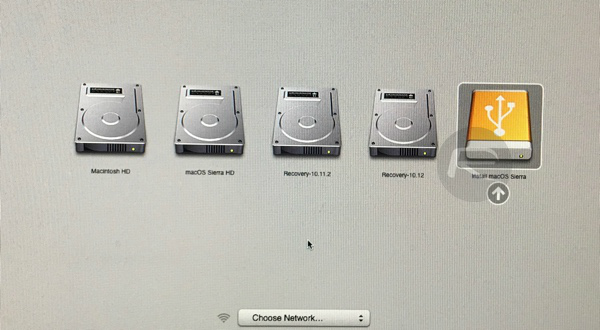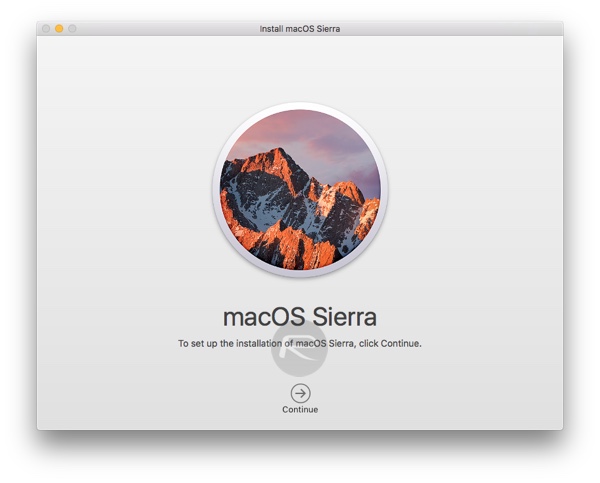Instructions on how to install macOS Sierra (clean install) 10.12 on Mac
After improving and changing some features on the Beta version, the final version (the final version) of macOS Sierra 10.12 was also released by Apple. If you want to install macOS Sierra 10.12 and experience the new features of this version on Mac, please refer to the steps in the following article of Network Administrator.

Part 1: Requirements
- First, make sure that the data and important files have been backed up to make sure that the data and files are not lost during execution.
- Mac supports installing macOS Sierra.
Mac list compatible with macOS Sierra:
- MacBook - late 2009 and later
- iMac - late 2009 and later
- MacBook Air - 2010 and later
- MacBook Pro - 2010 and later
- Mac Mini - 2010 and later
- Mac Pro - 2010 and later
Part 2: Install new macOS Sierra
Step 1:
First access the Mac App Store to download macOS Sierra version 10.12 Final.
If you haven't downloaded the macOS Sierra version 10.12 Final, then Mac App Store will prioritize downloading the installer file and then guide you through the steps to install. When you finish downloading the installer, make sure you exit the installer to use this installer for other purposes.

Step 2:
Once you have downloaded the installer, the next step is to use this installer to create a bootable USB drive, this bootable USB drive allows you to install macOS Sierra on the Mac.
This means installing new, not upgrading from other settings like El Capitan or Yosemite.
Refer to the steps for creating macOS Sierra 10.12 installer using USB here.

Step 3:
With the newly created USB Bootable drive, the next step to do is plug the USB drive into the Mac and start the Mac to appear a question from the cold start (cold start).
When the Mac restarts, make sure that you press and hold the Option key during the boot process to bring up a new menu on the screen, which gives you options to boot from. Finally, make sure you select the USB bootable drive plugged into Mac and press Enter to continue doing the following steps.

Step 4:
After the device has finished checking and running the program, the macOS Utilities menu will appear on the screen. Make sure you select Disk Utility from the options available, then select Continue to take the next steps.

Step 5:
When Disk Utility is loaded, make sure that the main hard drive on the Mac is selected in the left pane, then click the Erase button .
Make sure that the Name frame is still 'Macintosh HD' and that in the Format format box, select 'Mac OS Extended (Journaled)'. Then click the Erase button and all data will be erased.

Step 6:
The current installation will be wiped clean. Now macOS Utilities menu appears again. Your task is to select Install macOS and select Continue.

A new window appears, where you click Continue and make sure that Macintosh HD is selected, this is the hard drive platform on the Mac, then click Install.

Now the new macOS Sierra installation process will begin.
Refer to some of the following articles:
- Instructions for using hidden icons on Mac keyboard
- Steps to install Windows 7 on Mac using Boot Camp
- Instructions from AZ how to install Windows 10 on Mac
Good luck!
You should read it
- Free space on macOS Sierra with Optimize Storage
- How to customize message notifications on macOS Sierra
- Useful tips for macOS 10.12 Sierra
- Synchronize files and folders on Desktop and Document on macOS Sierra with iCloud
- How to change the shortcut to use Siri on macOS Sierra
- How to create a MacOS Sierra installed USB drive 10.12
- How to turn off the Gatekeeper on macOS Sierra install the application outside the App Store
- How to disable iTunes automatically launch on macOS Sierra
May be interested
- Useful tips for macOS 10.12 Sierra
 macos 10.12 sierra is apple's new operating system, possessing many new features such as siri virtual assistant, photo application upgrade, or messenger application.
macos 10.12 sierra is apple's new operating system, possessing many new features such as siri virtual assistant, photo application upgrade, or messenger application. - What's remarkable in the new macOS version 10.13 High Sierra?
 along with ios 11, macos 10.13 high sierra is the operating system that will be officially released by apple in 2017. so what are the changes and upgrade features on this operating system?
along with ios 11, macos 10.13 high sierra is the operating system that will be officially released by apple in 2017. so what are the changes and upgrade features on this operating system? - Do you know 3 window management features on macOS Sierra?
 when upgrading macs to macos sierra, there are many features and tips that you don't know about. for example, when performing tricks with multiple windows of the application on macos sierra.
when upgrading macs to macos sierra, there are many features and tips that you don't know about. for example, when performing tricks with multiple windows of the application on macos sierra. - How to activate Hey Siri on macOS Sierra
 one of the most prominent features on the macos sierra is siri of ios. on ios devices, users can quickly activate siri by voice with the command 'hey siri', but currently, on macos sierra, this feature is not available. however, if you want mac users can still activate hey siri on macos sierra manually.
one of the most prominent features on the macos sierra is siri of ios. on ios devices, users can quickly activate siri by voice with the command 'hey siri', but currently, on macos sierra, this feature is not available. however, if you want mac users can still activate hey siri on macos sierra manually. - Which items need attention when cleaning up memory on macOS?
 cleaning up the memory on macos sierra will help the machine run faster, especially able to regain large storage capacity for the system.
cleaning up the memory on macos sierra will help the machine run faster, especially able to regain large storage capacity for the system. - Instructions for activating Dark Mode on macOS Sierra
 dark mode is one of the most notable features on the mac. when dark mode is activated, the interface on the mac will change, turning dark. and just like on windows, when activating dark mode on the mac, it also saves battery life and also prevents users' eyes (especially at night).
dark mode is one of the most notable features on the mac. when dark mode is activated, the interface on the mac will change, turning dark. and just like on windows, when activating dark mode on the mac, it also saves battery life and also prevents users' eyes (especially at night). - How to use Launchpad on macOS Sierra
 launchpad is the default tool on mac used to manage all the applications we have installed on the device. thanks to this tool, you can access the application more quickly and easily. so does the launchpad usage on the macos sierra change?
launchpad is the default tool on mac used to manage all the applications we have installed on the device. thanks to this tool, you can access the application more quickly and easily. so does the launchpad usage on the macos sierra change? - How does macOS High Sierra unlock? How to stop?
 there seems to be a vulnerability in macos high sierra 10.13.1, even from the login menu when starting the computer for the first time. let's see how the macos high sierra unlocked and how to stop it.
there seems to be a vulnerability in macos high sierra 10.13.1, even from the login menu when starting the computer for the first time. let's see how the macos high sierra unlocked and how to stop it. - How to perform a clean install of macOS 10.15 Catalina
 this article guides you through the process of a clean install of macos 10.15 catalina, using a bootable usb, instead of upgrading your mac using apple's standard installation package, retaining existing data and all applications due to user settings.
this article guides you through the process of a clean install of macos 10.15 catalina, using a bootable usb, instead of upgrading your mac using apple's standard installation package, retaining existing data and all applications due to user settings. - Show ~ / Library folder on macOS Sierra
 directory ~ / library / on macos sierra contains preference files, cache and application data. however, by default, the user library folder is hidden on macos sierra. in some cases you may have to display and access this folder.
directory ~ / library / on macos sierra contains preference files, cache and application data. however, by default, the user library folder is hidden on macos sierra. in some cases you may have to display and access this folder.










 How to create a MacOS Sierra installed USB drive 10.12
How to create a MacOS Sierra installed USB drive 10.12 Instructions to turn off Focus Ring Animation on Mac
Instructions to turn off Focus Ring Animation on Mac Instructions for activating macOS Sierra's Picture-In-Picture (PiP) mode with YouTube
Instructions for activating macOS Sierra's Picture-In-Picture (PiP) mode with YouTube How to turn off the Gatekeeper on macOS Sierra install the application outside the App Store
How to turn off the Gatekeeper on macOS Sierra install the application outside the App Store Steps to install Windows 7 on Mac using Boot Camp
Steps to install Windows 7 on Mac using Boot Camp